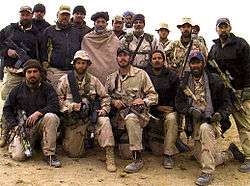Fall of Kandahar
| Fall of Kandahar | |||||||
|---|---|---|---|---|---|---|---|
| Part of the Afghan Civil War and the War in Afghanistan | |||||||
 Aerial view of a section of Kandahar | |||||||
| |||||||
| Belligerents | |||||||
|
|
| ||||||
| Commanders and leaders | |||||||
|
| Mullah Omar, Akhtar Mansur, Obaidullah Akhund, Abdul Ghani Baradar, Abdul Razzaq, Tayyib Agha, Naqibullah, Hafiz Abdul-Majeed | ||||||
| Strength | |||||||
|
800 Sharzai's militia 800 Eastern Alliance 750 Americans 150 Australians | |||||||
| Casualties and losses | |||||||
| 3 Americans killed | |||||||
The Fall of Kandahar took place in 2001 during the War in Afghanistan. After the fall of Mazar-i-Sharif, Kabul and Herat, Kandahar was the last major city under Taliban control. Kandahar was where the Taliban movement had originated and where its power base was located, so it was assumed that capturing Kandahar would be difficult. The city fell after several weeks of fighting to a force of local militia under Pashtun military commanders and their American advisers. The fall of Kandahar signaled the end of organized Taliban control of Afghanistan.[1]
Battle

On 19 October, 200 Rangers from the 3rd Ranger Battalion (75th Ranger Regiment) departed from four Lockheed MC-130 aircraft towards a desert landing strip south of the city on an "objective Rhino", supported by 750 U.S. soldiers from the United States Army's 101st Airborne Division to create a forward base at Camp Rhino 100 miles south of Kandahar.
Anti-Taliban commander Gul Agha Sherzai was contacted by an American special forces A-team on November 18. His forces numbered about 800 men, but were severely outnumbered and under-equipped. After receiving supplies, they moved out on November 22 in a convoy of over 100 vehicles and began advancing on Kandahar through the Arghastan desert. Attempting to bypass Taliban strongholds, Sharzai's convoy halted outside the Taliban-held town of Takht-e-pol. While trying to negotiate a surrender, the convoy was ambushed by Taliban forces. Sharzai's forces drove the Taliban back with the help of American air support. The Taliban retreated and abandoned the Takht-e-pol area.
Before the 15th Marine Expeditionary Unit of the United States Marine Corps arrived at 'Rhino' on 25 November, a recce team from SEAL Team 8 carried out a reconnaissance mission, but were mistakenly engaged by AH-1W Cobra attack helicopters, they managed to get a message to the marines before anyone was wounded.[2]
On 25 November, FOB (Forward Operating Base) Rhino was established outside of Kandahar, cleared in by the SEALs [3] the 15th MEU relieved the 101st Airborne Division of control of FOB Rhino and continued forward operations throughout Kandahar with coalition forces. On November 27, the 15th MEU was joined by a unit of the Australian Special Air Service Regiment and began joint operations against Taliban forces.
After the Battle of Tarin Kowt, the Eastern Alliance under the command of Hamid Karzai spent several weeks in Tarin Kowt attracting recruits. His forces swelled to around 800 men as he prepared to move on Kandahar from the north. On November 30, Karzai's force began advancing towards the town of Petaw. After taking Petaw without a fight, Karzai's force attempted to take the bridge at Sayd Alim Kalay but was halted by stiff Taliban resistance. After a two-day battle involving heavy airstrikes the Taliban withdrew on December 4, leaving the bridge intact. Karzai's force seized a bridgehead on the other side.
The next day, a stray American bomb landed on an American position, killing three special forces soldiers and wounding Karzai. Karzai's men maintained their positions and began negotiations with the Taliban for the surrender of Kandahar.
On December 7, Sharzai's men began their assault on Kandahar's airport, but met little resistance. They discovered that the Taliban had already surrendered the city to Karzai's forces. Sharzai's men entered the city and Sharzai was declared governor of Kandahar. Karzai had already been declared president of Afghanistan.[4]
References
- ↑ On The Ground – The Fall Of Kandahar | Campaign Against Terror | FRONTLINE | PBS
- ↑ Neville, Leigh, Special Forces in the War on Terror (General Military), Osprey Publishing, 2015 ISBN 978-1472807908, p.44
- ↑ Neville, Leigh, Special Forces in the War on Terror (General Military), Osprey Publishing, 2015 ISBN 978-1472807908, p.43
- ↑ "The United States Army in Afghanistan – Operation ENDURING FREEDOM – October 2001 – March 2003".
Coordinates: 31°37′N 65°43′E / 31.617°N 65.717°E